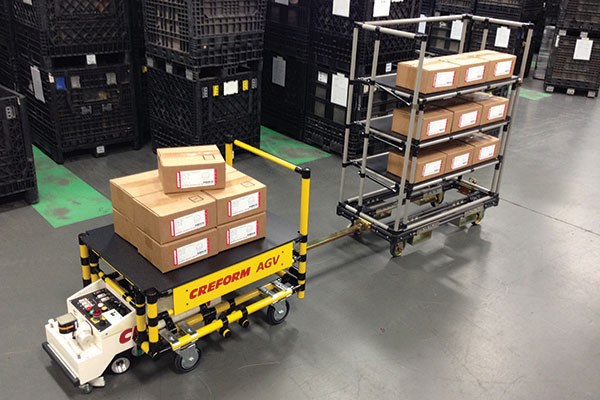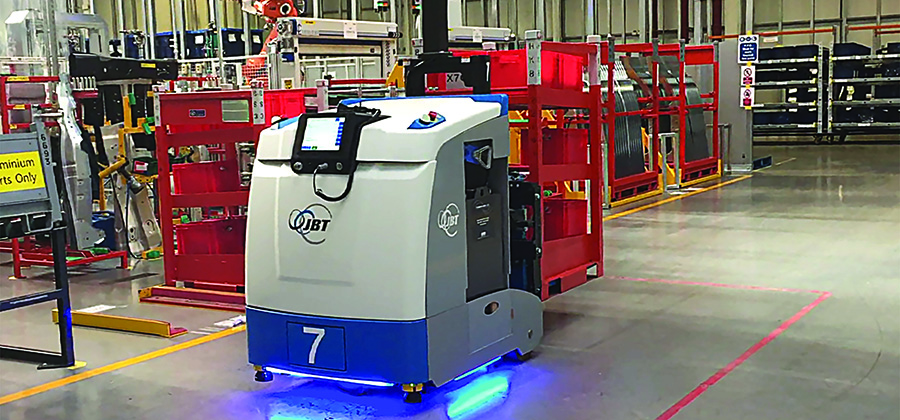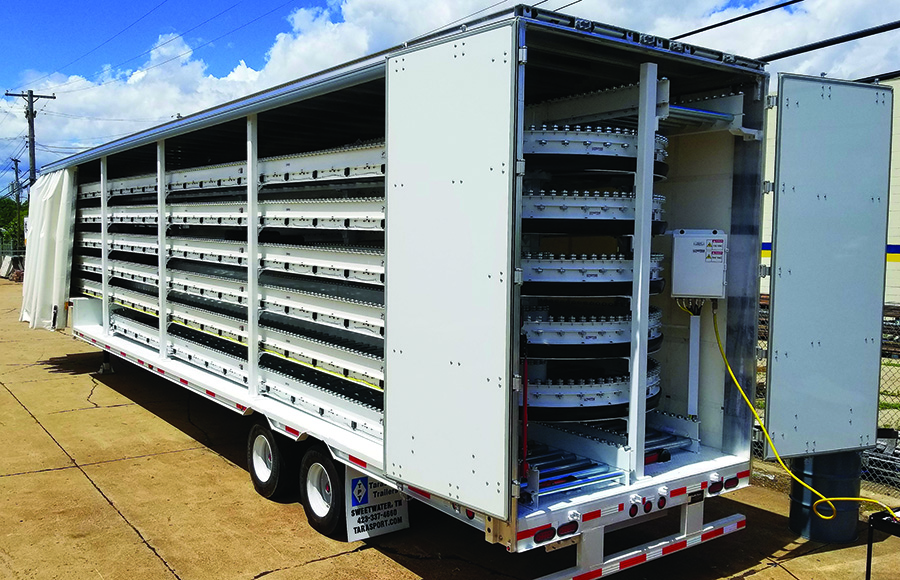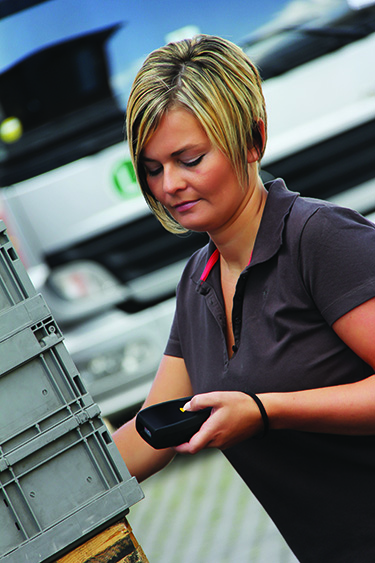Automotive materials handling: Anything but routine
Automakers are finding new ways to improve operations and reduce costs while accommodating fickle consumers who want every feature imaginable. That’s typically a tall order, but it’s even more so in the highly competitive auto industry.

Sometimes it’s worth a minute to review some of the basics of an industry before talking about its materials handling trends. Automotive is one of those. So, here we go.
Last year, roughly 17 million light trucks and cars were sold in the United States. Light trucks accounted for 70% of that number. Electric vehicles (EVs) were about 2%. In 2019, there were 257 models with 36 of those considered new models. However, 257 is quite a comedown from more than 400 models sold 15 years ago.
As we all know, automatic transmissions dominate. Manual transmissions are in just 20% of all models. However, EVs will make both manual and automatic transmissions obsolete.
On the surface, it sounds like we’re trending toward fewer options than before. But, nothing could be further from the truth. Instead, options have proliferated. Just think back to the last time you wrestled with a car dealer to get all of the specific features you wanted.
While none of us gives a hoot about what it takes for the automaker to build each vehicle as quickly and efficiently as possible in large numbers, it’s even worse than we can imagine. Your car and mine are right next to each other as they move down the assembly line. And, you sure don’t want my ugly wheels.

A forked AGV lifts, positions and stacks a rack of parts.
Clearly, building a new vehicle isn’t getting any easier. And that’s where materials handling is having its biggest impact on the auto industry today.
Key trends here include:
- cost reduction through automation,
- error-free, in sequence parts delivery to the line,
- maximum density to optimize efficiency,
- transparency and visibility, and
- connected operations on the way to digital.

A curtained over-the-road truck has several layers of curved roller conveyor to protect and handle wheel tire assemblies.
Meanwhile, we’re at the very early stages of the move to EVs. On one hand, that shift will reduce the number of parts that go into a vehicle. Some say as much as 50%. The impact that shift will have on the automotive workforce was the centerpiece of auto industry labor negotiations last year.
However, auto companies will be balancing a long-term transition from internal combustion cars to EVs for many years to come. That change will bring on its own host of materials handling challenges.
The power of automation
Ask suppliers about the trajectory of automation in automotive, and you get a range of answers. On the one end is a projection that almost all materials handling will be automated in the next 10 years. Others predict a more gentle move to automation. The timeline specifics are probably less important than the steadily increasing move to automation overall.
“There are heavy pressures on auto companies to reduce costs, and automation is central to that effort,” says Greg Pachuta sales manager at JBT. With the labor contracts settled last year, he says, automakers are in a better-defined position to move ahead with automation on a broader scale.
“Various aspects of building cars are either fully or nearly fully automated already. Painting and welding are two examples,” explains Matt Rendall, CEO or OTTO Motors. But as he points out, much of materials handling today is still manual. That, he says, will be a problem going forward. “If automakers don’t figure out large scale automation for materials handling, then it will become a major bottleneck and a cost drag.”
Fortunately, options are available for automakers. They range from automated wheel tire assembly handling to automated storage and retrieval systems (AS/RS), conveyors and a combination of automatic guided vehicles (AGVs), automated mobile robots (AMRs) and automated lift trucks.
Richard Canny, president of Ultimation, talks about automated handling of wheel tire assemblies from side curtained over-the-road trucks direct to assembly lines. Those trucks are stacked seven high with assemblies that move along curved roller conveyor until they exit the truck. There, in-plant conveyors move the assemblies to the line and to the mounting station. None of this was in place not so long ago. Today, it is not at all uncommon, and it’s growing.
Just as important as automated handling, says Canny, is error-free, in-sequence movement of those assemblies. This ensures efficiency and accuracy at mounting the right wheel tire to the right car coming down the line.
 It’s worth noting that error-free, in-sequence handling has become a core competency of building vehicles, regardless of the part. “Successful line production overall is all about the right part in the right sequence at the right time,” reiterates Canny. “The target,” he adds, “is always fewer sequence errors, less damage and higher productivity that translates into lower assembly costs.”
It’s worth noting that error-free, in-sequence handling has become a core competency of building vehicles, regardless of the part. “Successful line production overall is all about the right part in the right sequence at the right time,” reiterates Canny. “The target,” he adds, “is always fewer sequence errors, less damage and higher productivity that translates into lower assembly costs.”
Making this happen isn’t always a slam dunk, however. Different parts of the line move at different speeds. That requires buffering and accumulating conveyors, especially zero-pressure accumulation, to pace the in-sequence delivery of parts. The result is handling complexity and increased opportunities for error.
AS/RS is becoming increasingly important here, too, says Robert Humphry, manager of system sales at Bastian Solutions. “Space constraints are common. Some facilities are landlocked not to mention the departments within those facilities. So, automakers have to maximize density in the overall process to optimize efficiency,” he says.
Humphry cites the efficiency gains of ultra-dense AS/RS as a major weapon. Big is good here. He talks of high-bay 120-foot-tall and taller rack-supported buildings with a minimum of aisles and up to 12-deep storage. This is a trend that will continue for the foreseeable future, says Humphry.
Automation that moves
AGVs have long been an important and visible part of the assembly process. While best known as tuggers of trains of parts over long distances, forked AGVs have also been used to lift, position and stack racks of parts, especially in what is known as supermarket parts staging areas.
Automotive’s interest in AGVs, says Creform’s vice president of sales Keith Soderlund, is three-fold—predictability that removes human error, safety and answering the lack of people needed to get the job done.
Those supermarket staging areas are prime example of all three at work, says Soderlund. “It’s all about inventory management and error-proofing picks, sequence sets and movement to the line,” he adds. Because there is so little extra space lineside, it’s imperative for racks moved by small guided vehicles to move parts from the supermarket to the assembly location on a very just-in-time basis before returning to the supermarket for another load.
Automated lift trucks are also a part of this landscape. Now it’s important to note that no supplier of lift trucks supplies automated lift trucks to automotive. Instead, AGV suppliers such as JBT provide retrofit kits for lift trucks. Pachuta of JBT sees that trend continuing as automakers work to eliminate labor wherever possible.
AMRs, however, are the untapped frontier for automotive automation. Today, only a few AMRs are working in automaker plants in the United States, or elsewhere for that matter. However, that is going to change, says Melonee Wise, CEO of Fetch Robotics. “Automakers want maximum flexibility to optimize their processes,” she says. “The ability of AMRs to create a path on the fly that accommodates workflow modifications even by the day has great potential.”
AMRs are better suited to moving smaller loads than AGVs traditionally have, observes Wise. One of these pioneer applications is at third-party logistics provider Universal Logistics Holdings in Smyrna, Tenn. The 1-million-square-foot facility serves the nearby Nissan plant, the largest in North America. Ten Fetch robots work with 40 carts to automate several key processes in the warehouse, freeing people to do more valuable work.
Rendall says OTTO Motors has AMRs in several Japanese plants. Tier 1 supplier HIROTEC Hiroshima uses AMRs to deliver Mazda door panels to welding cells in Japan. Meanwhile, Toyota uses them to sequentially load and deliver parts lineside at plants in the United States.
Better connections
Just as automation creates better handoffs on the physical handling side of automaking, several advances on the information side are making plants better connected and production more transparent and visible.
Ten years ago, Wi-Fi was uncommon in auto plants. Today, it’s just the reverse. But that’s only a first step. “We’re still in the early stages of harnessing information in plants. Wi-Fi is a first step toward a digital facility. First, the machines have to be connected to establish a flow of information,” says Rendall.
As Bastian’s Humphry explains, cameras are part of making those connections. Cameras for parts inspection as well as tracking parts movement along with bar codes are part of this shift, he adds.
“RFID is also contributing to improving visibility. Being able to locate goods throughout the supply chain is a growing concern for all OEMs,” says Dana McBrien, guiding architect for AutoSphere at Surgere.
A leading application here is tracking returnable containers with RFID, says Andy Schumacher, vice president of the packaging division at SSI Schaefer. He estimates that 15% of all returnables are tracked with RFID today. That number will continue to grow especially over the next three years. For more details, see Modern’s Packaging Corner from the March issue.
The times are changing
For some time now, says Canny of Ultimation, model changeover times have become shorter and shorter. What used to be two to three months is now 30 to 45 days.
Tesla fits right in to this trend. “Tesla is willing to pick partners quickly and expects its partners to be quick about materials handling equipment installs, too,” adds Canny. Furthermore, the handling needed for EV parts is different than internal combustion cars because the parts themselves are different.
That combined with shorter changeover times is fundamentally changing materials handling systems. “Modular solutions and even pre-configured ones are going to become increasingly in demand,” says Canny.
Automakers are starting to prepare for these shifts in materials handling, says Soderlund of Creform. “This will be a 10- to 20-year transition and people are just trying to understand it now. It’s impossible to say definitively today what all this means. It will definitely transform materials handling and well shrink its footprint in auto plants. Automakers are just going to have to operate differently,” he concludes.
Clearly, automotive is anything but routine.
Companies mentioned in this article:
Bastian Solutions
Creform
Fetch Robotics
JBT
OTTO Motors
Ultimation
SSI Schaefer Systems International
Surgere

Article Topics
Latest in Logistics
LM Podcast Series: Assessing the freight transportation and logistics markets with Tom Nightingale, AFS Logistics Investor expectations continue to influence supply chain decision-making The Next Big Steps in Supply Chain Digitalization Under-21 driver pilot program a bust with fleets as FMCSA seeks changes Diesel back over $4 a gallon; Mideast tensions, other worries cited Four U.S. railroads file challenges against FRA’s two-person crew mandate, says report XPO opens up three new services acquired through auction of Yellow’s properties and assets More LogisticsSubscribe to Logistics Management Magazine

Find out what the world's most innovative companies are doing to improve productivity in their plants and distribution centers.
Start your FREE subscription today.
April 2023 Logistics Management

Latest Resources














